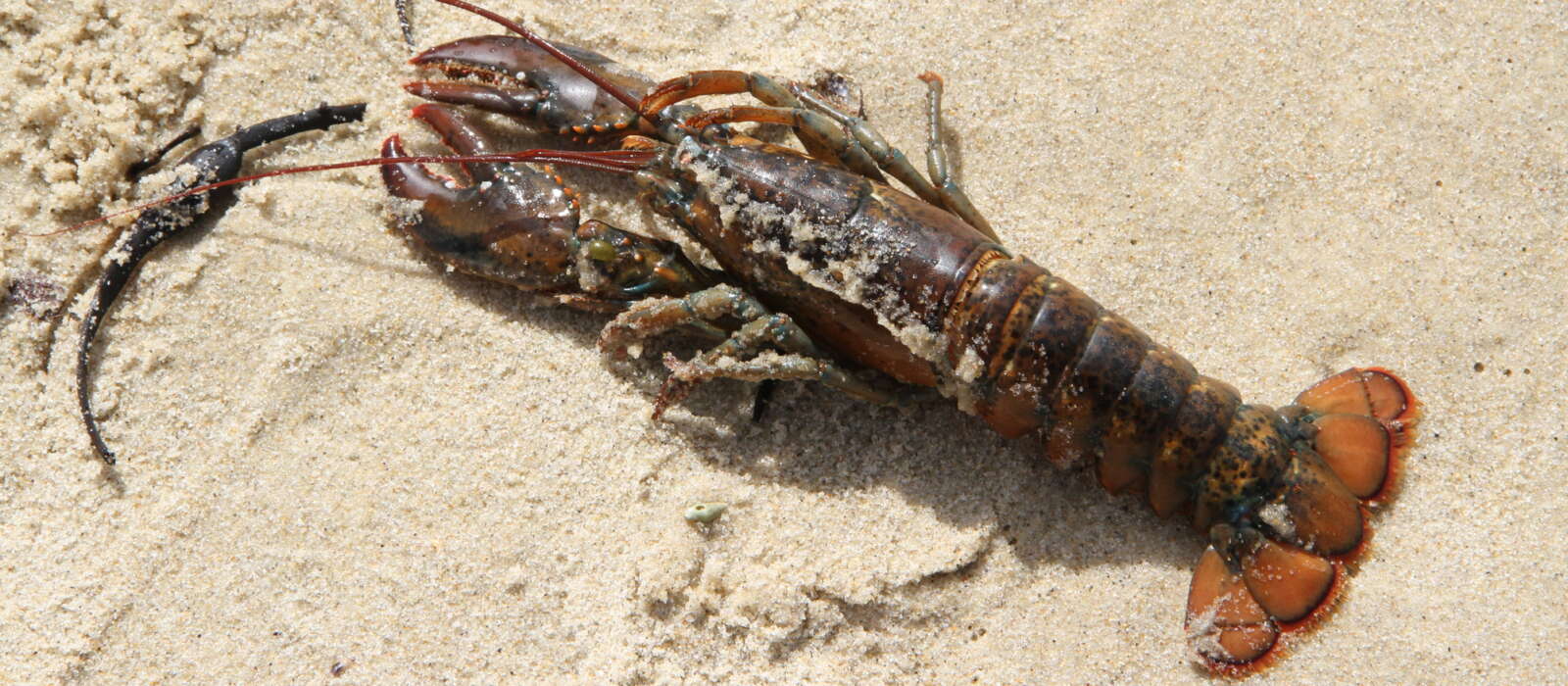Marine Crustacea
In the taxonomic classification system presented in Margulis and Schwartz 1998, the Arthropods are divided into ten phyla, leaving aside species only known as fossils from the Cambrian Period about 500-550 million years ago. One of these phyla, Crustacea, has six classes which include at least 45,000 described species in about 5,350 genera. Of those species about 5,750, or about 13%, occur in freshwater, brackish water, or terrestrial habitats (Abele, 1982). The defining feature of these species is that they have two pairs of antennae on the head. In this section, we are only concerned with those species that live primarily in salt water. Representatives of only three classes have been found in our area: Malacostraca, Maxillipoda, and Ostracoda. The most important survey of these species in the waters around the island is that of Sumner et al. (1913), although the taxonomy used in that work is somewhat out of date. More recent publications by Abele (1982), Williams (1984), and Wilson (1932) provide most of the taxonomy given here.
Wilson (1932) lists 373 species of Copepods known from an area 150 miles long and 200 miles wide more or less centered on Woods Hole and including all of Cape Cod and Nantucket. The specific waters of Martha’s Vineyard are indicated for the 180 species listed in the accompanying checklist. Reports for as far south as the edge of the continental shelf are not included here though several more species, including some found only in the Gulf Stream, have been found there. Each family is indicated as free-living (31) or parasitic (17); where available, hosts on which parasitic species have been collected are mentioned. Some parasitic copepod species are found on only a single host fish species; others occur on several or many species.
Cushman (1906) reported 26 species of Ostracods in “Vineyard Sound and adjacent waters” versus the 18 listed below; some of the 26 he lists were taken in brackish ponds on Cape Cod. Most of the species he included have northern affinities, and 16 of the 26 species are also found in Europe.
Williams (1984) is the basis for our treatment of the taxonomy, status and distribution of the salt-water shrimps, lobsters, and crabs (Decapods) for our area. There are 30 species for which the northernmost report is our island, or nearly so. Conversely, there are only six species for which our area is the southernmost extent of their range.
Unfortunately, there do not appear to be any studies more recent than 1913 of the Amphipods, Ostracods, or Isopods of Martha’s Vineyard, specifically. Searches of relevant databases at the Marine Biological Laboratory in Woods Hole, which go back to 1978 in two cases (ASFA, Zoological Record) and 1982 in another (Biological Science), failed to provide help on more modern taxonomy for several species. Therefore, several species will be listed below where the generic or specific name or both are contained in brackets with a question mark to indicate that the taxonomy has apparently been revised between 1913 and 1982, but we have not been able to find out how the names have been changed. It is unfortunate that there is so little work being done now in this area. A useful field guide that illustrates selected amphipods, isopods, copepods, shrimps, crabs and barnacles from our area is Gosner (1979).
The only group within the marine crustaceans for which we have useful data on zoogeographical affinities is the Decapods. That Martha’s Vineyard is in a transition zone between northern and southern fauna is shown by the relatively large number of species near the northern and southern extremities of their ranges. The balance tips in favor of species with southern affinities.
Some may ask why we have bothered to list here 376 crustacean species, many of which are tiny or obscure ones that the average person will probably never see and which will be of interest only to specialists. There are two reasons. The first is to illustrate the remarkable diversity of such species that can be found by diligent workers even in our tiny little corner of the planet. And this list is surely incomplete. Second, we hope that someday a specialist will come along who will want to know about all the obscure species, will help correct any mistakes we have made with names, and will tell us about even more species that occur here.
Allan Keith; edited by Matt Pelikan, May 22, 2023
References
Abele, L. G., Ed. 1982. The biology of Crustacea. Vol. 1 – Systematics, the fossil record and bibliography. Academic Press, New York.
Cushman, J. A. 1906. Marine Ostracoda of Vineyard Sound and adjacent waters. Proceedings of Boston Society of Natural History, 32(10):359-385.
Richardson, H. 1908. Description of a new Isopod of the genus Eurycope from Martha’s Vineyard. Proceedings of the U. S. National Museum, No. 1598, Vol. 34, pp. 67-69. Government Printing Office, Washington, DC.
Williams, A. B. 1984. Shrimps, lobsters and crabs of the Atlantic coast of the eastern United States, Maine to Florida. Smithsonian Institution Press, Washington DC. 550 pp.
Wilson, C. B. 1932. The copepods of the Woods Hole region, Massachusetts. Bulletin 158, Smithsonian Institution, United States National Museum. U. S. Government Printing Office, Washington, DC. 635 pp.
Yamada, S. B. 2001. Global invader: the European Green Crab. Oregon State University, Corvallis, OR.123 pp.
